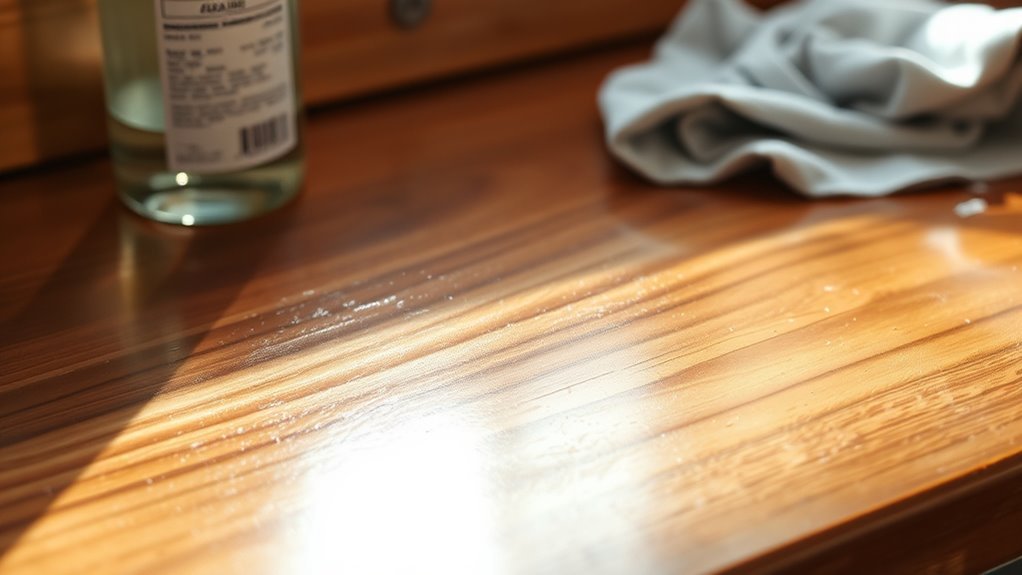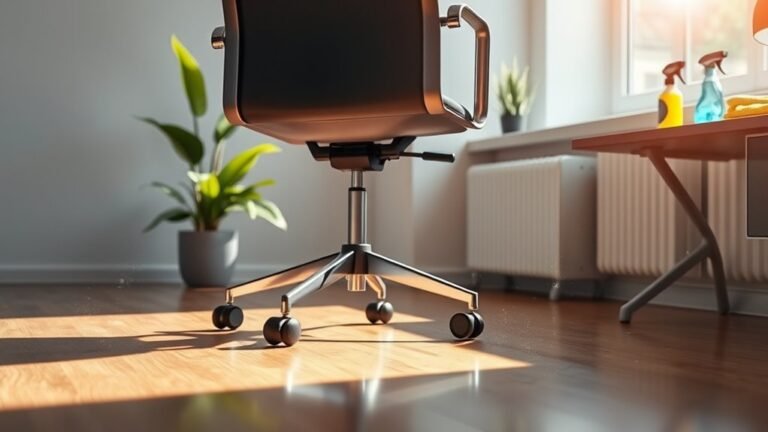Cleaning Mistakes That Damage Your Desk
You might be damaging your desk by using harsh chemicals that eat away finishes or by ignoring the manufacturer’s cleaning guidelines, which can void warranties. Using too much water can warp wood, while scrubbing with abrasive materials scratches surfaces. Skipping regular dusting allows grime buildup, and applying polish too often can harm protective layers. If you want to keep your desk looking great and lasting longer, there are a few more key pitfalls you’ll want to avoid.
Using Harsh Chemicals on Delicate Surfaces

While it might seem like a quick fix, using harsh chemicals on delicate desk surfaces can cause more harm than good. You might think strong cleaners will erase stains instantly, but chemical reactions often damage the finish, dulling or even eating away at protective coatings. If you want to keep your desk looking fresh and vibrant, you need to respect its surface protection. Instead of reaching for aggressive products, choose gentle, pH-balanced cleaners designed for delicate materials. This way, you maintain the desk’s natural beauty and extend its lifespan, granting you the freedom to enjoy your workspace without worry. Protecting your desk from harsh chemicals means fewer repairs and replacements, so you stay in control of your environment without sacrificing style or function.
Ignoring Manufacturer’s Cleaning Guidelines
Even if you choose gentle cleaners, using them without following the manufacturer’s instructions can still cause damage. Ignoring cleaning guidelines means you risk voiding warranties or harming your desk’s finish. Manufacturer recommendations are there to help you keep your desk looking its best while ensuring its longevity. To enjoy true freedom in your cleaning routine, always:
Using gentle cleaners without following manufacturer instructions can damage your desk and void warranties.
- Read and follow the specific cleaning guidelines for your desk material
- Use recommended products and avoid unapproved substances
- Pay attention to suggested cleaning frequency and techniques
Overusing Water During Cleaning

If you think using lots of water will make cleaning easier, you might be doing more harm than good. Over saturation issues can lead to moisture damage, warping wood, peeling finishes, and even mold growth. You want your desk to last, so control how much water you use.
| Cleaning Step | Water Use | Potential Risk |
|---|---|---|
| Light dusting | None or dry cloth | Safe |
| Spot cleaning | Damp cloth | Minimal risk |
| Deep cleaning | Slightly wet cloth | Watch for over saturation |
| Excessive scrubbing | Soaked cloth | High moisture damage |
| Quick wipe downs | Spray bottle mist | Controlled moisture |
Keep moisture minimal and let your desk air dry fully to avoid damage and maintain your freedom to work worry-free.
Scrubbing With Abrasive Materials
Because abrasive materials can scratch or dull your desk’s surface, you should avoid scrubbing with them. These abrasive effects leave visible surface scratches that not only ruin the look but weaken your desk’s finish over time. If you want to keep your space looking fresh and free, steer clear of harsh scrubbers.
Instead, focus on gentler options like:
- Soft microfiber cloths that lift dirt without damage
- Non-abrasive sponges designed for delicate surfaces
- Mild cleaning solutions that break down grime without scrubbing hard
Neglecting to Dust Regularly

When you skip regular dusting, dust and debris build up quickly, dulling your desk’s finish and making it harder to clean later. Neglecting this simple step leads to dust accumulation that can scratch surfaces and trap grime. Staying on top of regular maintenance frees you from stubborn messes and preserves your desk’s appearance. Here’s a quick guide to keep your workspace clean without hassle:
| Task | Frequency | Benefit |
|---|---|---|
| Light Dusting | Daily | Prevents dust buildup |
| Deep Cleaning | Weekly | Removes hidden debris |
| Use Microfiber Cloth | Every dusting | Protects surface finish |
| Avoid Harsh Chemicals | Always | Maintains material integrity |
Regular dusting is your ticket to a fresh, damage-free desk you’ll love.
Leaving Spills Unattended
A spill left unattended can quickly cause lasting damage to your desk’s surface. Whether it’s coffee, ink, or water, different spill types demand immediate attention to protect your workspace. Ignoring these messes not only stains but can warp or weaken materials, robbing you of that clean, free environment you value.
Immediate cleanup of spills prevents stains and damage, preserving your desk’s clean and durable surface.
To keep your desk safe, consider these preventive measures:
- Act fast: Blot spills immediately to prevent absorption.
- Know your desk: Use appropriate cleaners suited to your desk material.
- Protect surfaces: Use coasters or mats to catch accidental spills.
Using Paper Towels Instead of Soft Cloths
Paper towels might seem convenient for cleaning your desk, but they can actually cause scratches or leave behind lint, especially on delicate surfaces. To truly care for your workspace, consider paper towel alternatives like microfiber or cotton cloths. These cloth material types are gentle, reusable, and won’t harm your desk’s finish. Microfiber, in particular, traps dust and dirt without abrasive friction, preserving the surface’s integrity. By switching to these softer options, you’re not just cleaning—you’re protecting your desk’s longevity and appearance. So, ditch the disposable paper towels and embrace cloths that respect your furniture and reduce waste. This small change grants you freedom from damage and the hassle of replacing worn-out desks prematurely. It’s a smart, sustainable choice you won’t regret.
Applying Polish or Wax Too Frequently
Switching to soft cloths is a great step, but how often you polish or wax your desk matters just as much. Overdoing polish application frequency can lead to wax buildup effects that trap dust and grime, making your desk look dull rather than shiny. Plus, too much wax can clog the wood’s pores, limiting its natural breathability and causing long-term damage. To keep your desk looking fresh and free, follow these simple tips:
- Limit polish or wax application to once every few months
- Wipe off excess product with a clean, dry cloth
- Choose products designed specifically for your desk’s finish
Frequently Asked Questions
How Often Should I Deep Clean My Desk?
You should aim for a deep cleaning of your desk about once a month to keep things fresh and clutter-free. Maintaining a regular cleaning frequency helps you stay on top of dust and grime, making desk organization easier. When your space feels tidy, you’ll enjoy more freedom to focus and create without distractions. Remember, a clean desk isn’t just about looks—it’s about giving yourself the freedom to work smarter and feel better every day.
Can Sunlight Damage the Finish of My Desk?
Yes, sunlight exposure can definitely damage your desk finishes over time. If your desk sits in direct sunlight for long periods, the finish might fade, discolor, or even crack, which limits your freedom to keep your workspace looking fresh. To protect your desk, try positioning it away from windows or use curtains and blinds. This way, you can enjoy natural light without sacrificing your desk’s appearance or durability.
What Is the Best Way to Remove Ink Stains?
Imagine your desk as a canvas, and ink stains as unexpected splatters that threaten your masterpiece. For effective ink removal, gently dab the stain with a cloth dipped in rubbing alcohol or a specialized ink remover—don’t rub, or you’ll spread the mark. To embrace freedom from future messes, use stain prevention tactics like protective mats and quick clean-ups. This way, your workspace stays pristine, letting you create without limits.
Should I Use a Humidifier to Protect Wooden Desks?
You should definitely consider using a humidifier to maintain proper humidity control around your wooden desk. Wood loves stable moisture levels—it helps with wood preservation by preventing cracking or warping caused by dry air. When you keep humidity balanced, your desk stays strong and beautiful longer. So, if you want to enjoy your wooden desk freely without worrying about damage, a humidifier can be a great, low-maintenance ally.
Are Microfiber Cloths Safe for All Desk Materials?
You’ll find microfiber cloths super handy because their benefits include trapping dust and dirt without scratching surfaces. They’re generally safe for most desk materials, from wood to glass and metal. However, not all cloth types are created equal—some might be too rough or leave lint behind. So, choose quality microfiber cloths designed for delicate surfaces to keep your desk looking fresh while enjoying the freedom of easy, worry-free cleaning.






